Gloriosa lily (gloriosa rothschildiana) is a climbing tender perennial that is sure to catch the eye of anyone who likes dramatic flowers. The flame-colored red flowers have scalloped yellow edges and swept back petals.
If you have a bare trellis or a wall in your garden that needs spicing up, plant gloriosa and prepare yourself for the compliments that are sure to come your way!
The gloriosa climbing lily is perfect for growing in containers or in the garden – just make sure to give it a trellis or obelisk for those tendril tipped leaves to climb on!
One of the best things about the plant is that it attracts butterflies and is rabbit and deer resistant – likely because of its toxicity!
Keep reading to find out more about how to grow gloriosa superba rothschildiana.

What is a gloriosa lily?
Gloriosa lily, gloriosa rothschildiana, is a genus of 12 species of the family colchicaceae. The plant is native to tropical and Southern Africa and Asia. It has also been naturalized in Australia and the Pacific.
It is widely cultivated because of its beautiful blooms. Gloriosa is the national flower of Zimbabwe. It is considered a noxious weed in some parts of the USA as well as Australia and the Pacific region.
Gloriosa lily is not a true lily. Lilies belong to the family is liliaceae. The lily-like flowers of gloriosa rothschildiana is what gives the plant its most often used common name.
Other nicknames of this lily are very descriptive, too. It is also known as flame lily, fire lily, glory lily, climbing lily, creeping lily, cat’s claw, and tiger’s claw. One only has to look at a photo of the plant to see where the common names come from!

Gloriosa rothschildiana care
Would you like to amaze your friends with these amazing flowers? These tips will help you in growing gloriosa lily.
Sunlight and moisture needs for gloriosa lily
Gloriosa loves full sun but will grow in partial sunlight. 6-8 hours of sunlight a day is ideal.
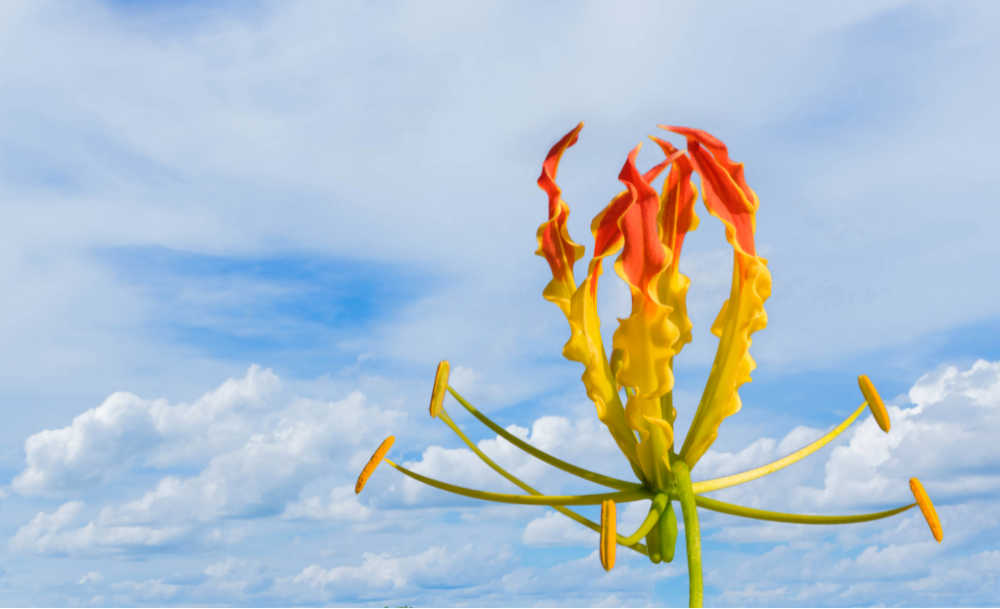
For those who live in hot southern climates, plant the tubers so that the flowers will get full sun, but the roots will remain shaded. Low growing shrubs around the plant will accomplish this.
Some protection from afternoon sunlight is helpful.
Prepare your soil by adding compost or other organic matter, such as peat moss or manure. This not only adds nutrients to the soil, it also helps it to drain well.
Half strength fertilizer applied every two weeks during the growing season will keep your gloriosa lily blooming vigorously all summer long, and even into fall.
Gloriosa rothschildiana prefers well draining soil that is kept moist, especially until the shoots appear in a few weeks.
Reduce the water to a couple of times a week or when the soil feels dry just below the surface. This plant requires about 1 inch of water a week, so extra water may be needed during hot, dry spells.
Gloriosa likes high humidity and is not happy in arid climates.
Planting tips for gloriosa lily
Plant the tubers in the spring once the soil has warmed and there is no danger of frost. Install your trellis and plant the tubers about 4 inches away from it.
Tubers are laid on their sides in the planting holes about 1 foot apart. Cover them with soil and firm down the soil well so that you don’t have any air pockets.
Glory lily prefers soil that is neutral to slightly acidic with a soil pH of 5.8 – 6.5.
A light well draining soil made for African Violets works well or make your own with a mix of 3 parts peat moss, 1 part sand and 1 part perlite.
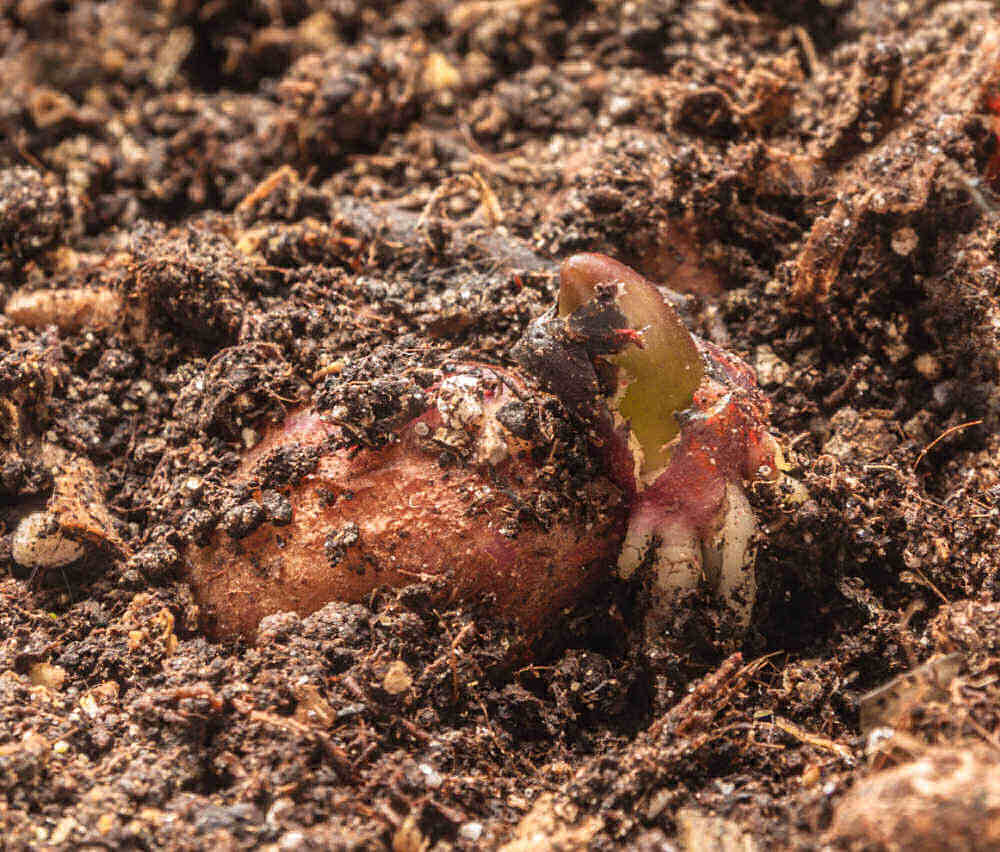
The tubers will sprout in 2-3 weeks. Keep them moist until this happens.
Mature size of flame lily
This stunning plant will grow to 60-72 inches tall. Glory lily does best when given a trellis or arbor to climb on.
Gloriosa does not produce tendrils in the normal way that vining plants do. Instead, the way that the leaves are shaped allows them to cling to a trellis or even another tall plant, like a sunflower. This pulls the vines upward for the dramatic show of flowers.

The tubers of gloriosa lily spread vigorously. It is classified as invasive in Australia, as well as several Pacific islands. No US state classifies it this way, but because of its potential to be invasive, it is recommended that you grow gloriosa lily in containers if you live in an area where it will over winter.
If you would like a wall of brilliant color that lasts all summer, gloriosa lily is the plant for you!
Flowering time
Gloriosa lily blooms in mid to late summer. The plant is fairy tidy, so deadheading it does not require too much pruning.
Deadheading the spent blooms on this lily will promote more flowers. Check out this post for tips on deadheading. For those of you who hate this task, check out this post for plants that don’t need deadheading.
The showy flowers appear on flower stalks up to 7 1/2 inches long. Each flower has 6 widely spaced petals that bend backwards and 6 outward spreading stamens that can be up to 1 1/2 inches long.
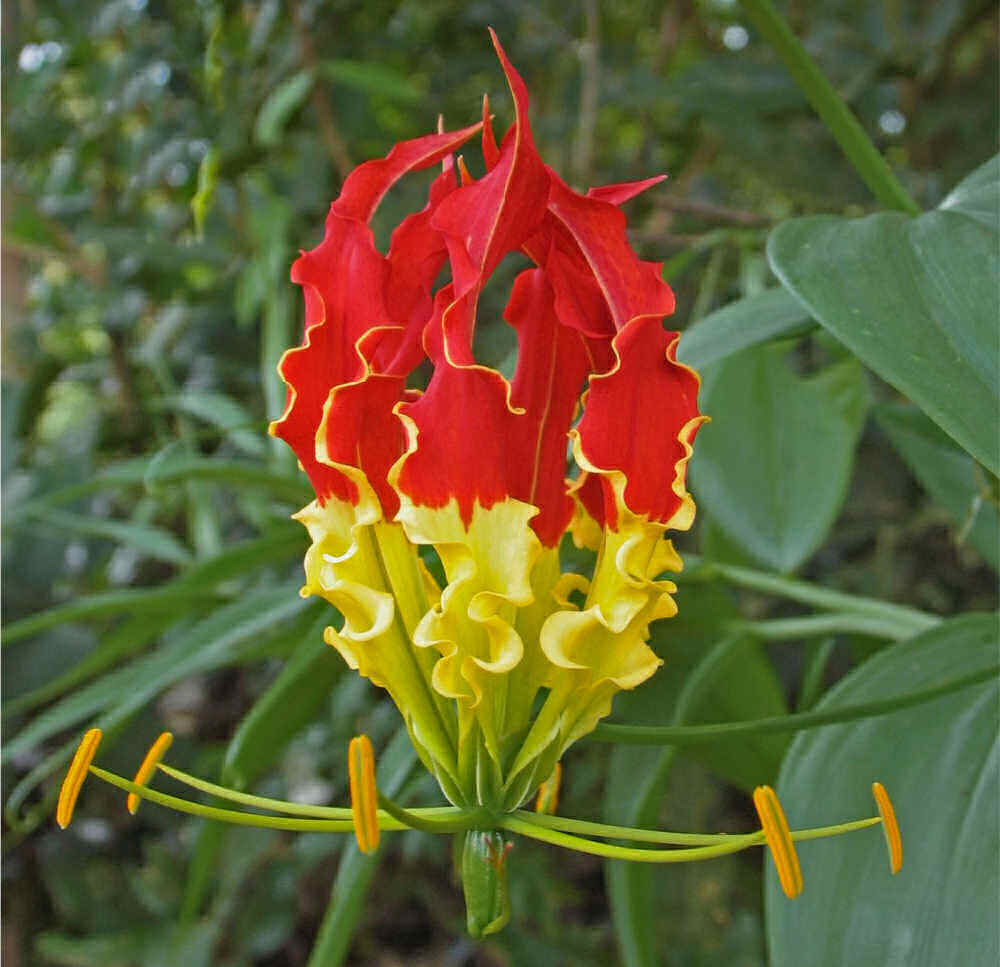
Flowers come in brilliant combinations of dark red, bright pink, orange, yellow, and striped pink.
The flowers can be used as cut flowers and are prized by florists since they last quite well in vases indoors.
The leaves occur in alternate spacing but some may be opposite, too. The have a lance like shape and are tipped with tendrils. Leaves are about 5-8 inches long
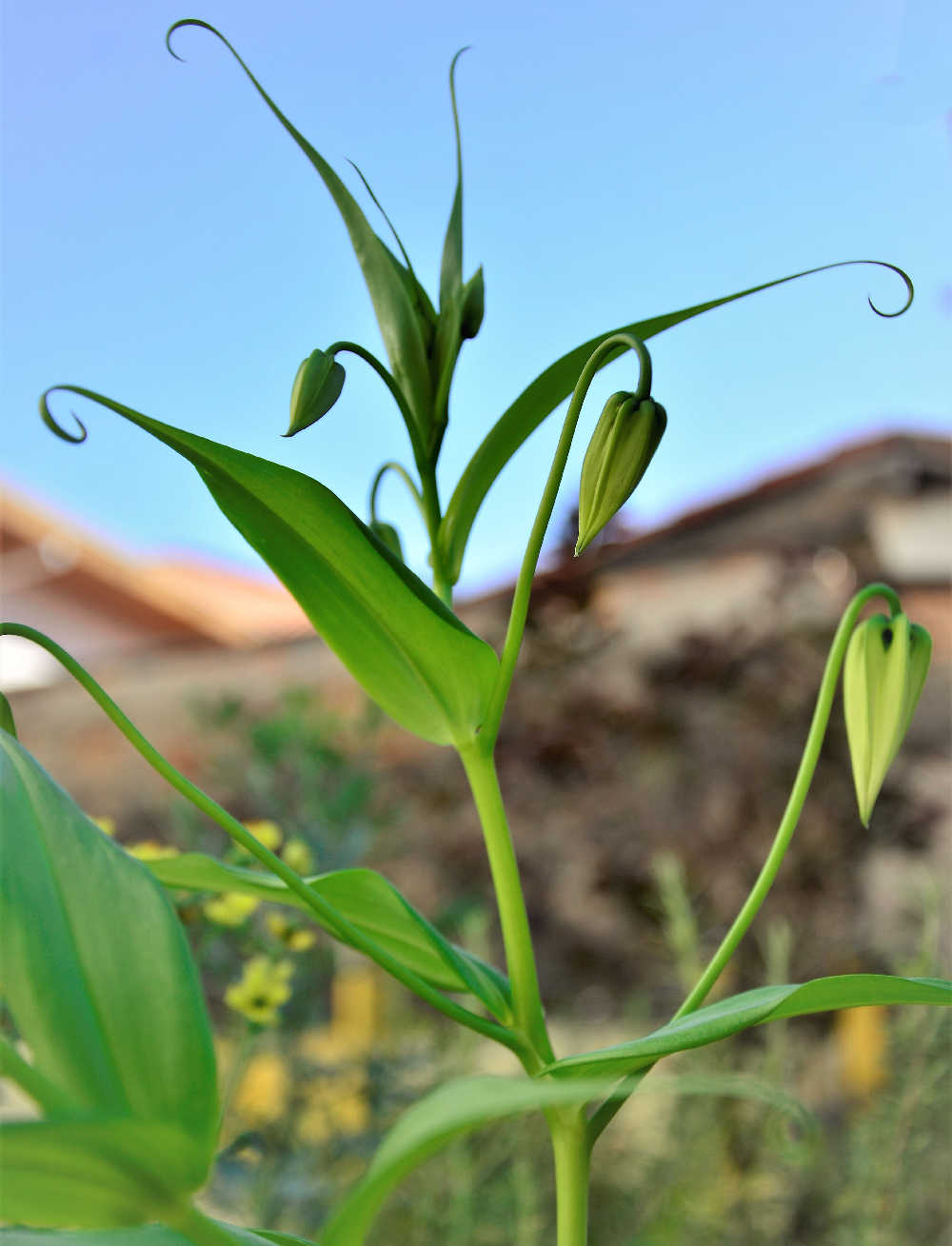
The leaves of gloriosa lily appear in the spring. After flowering, the stems die back.
Propagating gloriosa lily
Flame lily grows from tubers which go dormant during the winter. To get more plants, divide the tubers about once every three years.

Gloriosa lily can also be grown from seeds.
Common pests and diseases
Gloriosa lily may sometimes be infected with cucumber mosaic virus, root rot and can be attractive to aphids.
If you notice the leaves of your plant turning dry and pale colored, this is likely because of too much sun, rather than a disease. Try moving the plant so that it will get some afternoon shade.
Curling leaves might indicate that red spider mites have taken a liking to the plant. Spraying the entire vine when you water will help keep them away.
Is gloriosa lily a perennial?
Gloriosa lily is grown as a perennial in mild climates – USDA hardiness zones of 9-11. ( It might over winter in Zone 8 with mulching.) In colder areas, USDA 3-7, it is grown as a summer bulb because of the dramatic flowers.
You can enjoy the flowers all summer long, and then either let it die underground, or lift and store the tubers and plant them again in the spring.
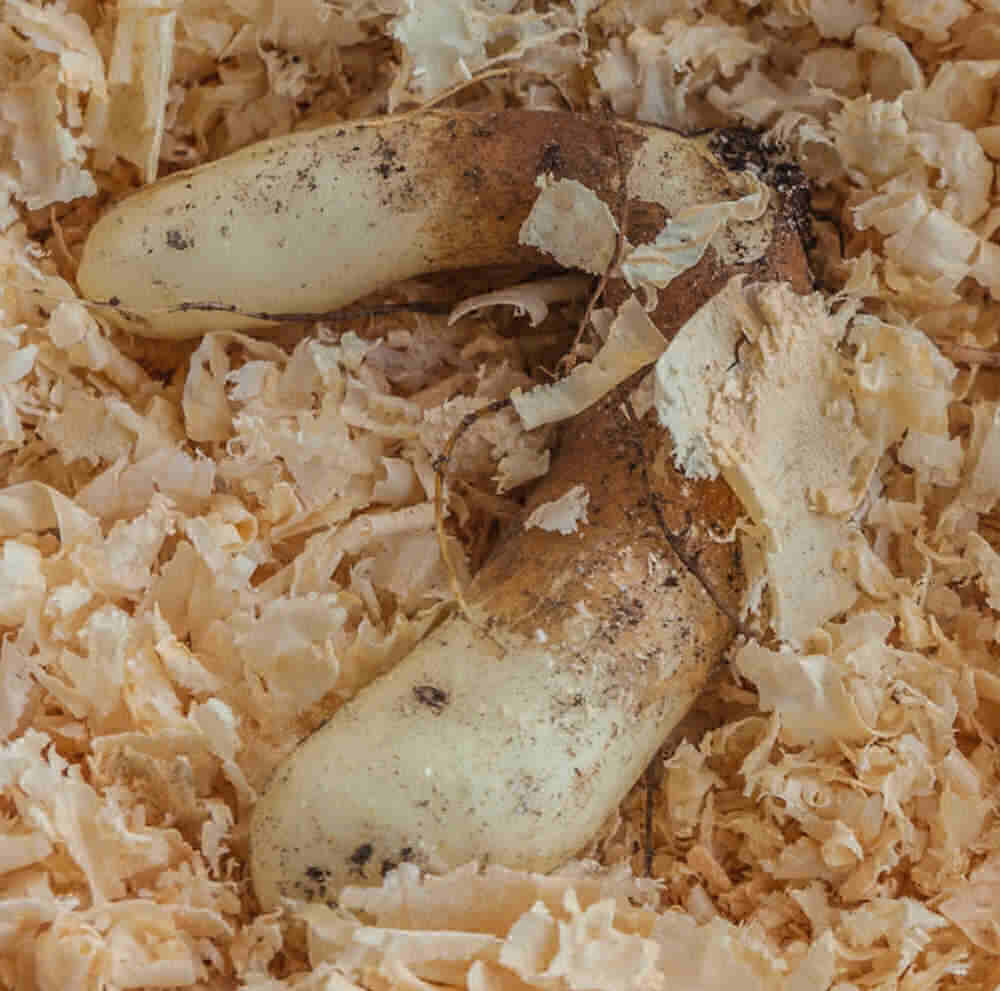
Place the tubers in lightly damp peat moss and allow them to rest for a few months before replanting.
How poisonous is flame lily?
All members of the colchicaceae family are poisonous and gloriosa is no exception
All parts of this plant are poisonous. It contains high levels of the toxic alkaloid colchicine. The most poisonous part of the plant are the tubers.
If ingested, gloriosa lily can be fatal to both humans and animals.
Like many toxic plants, such as foxgloves (digitalis), lower doses have been used in traditional medicine. The medicine colchicine is often used to treat gout.
Some of the the links below are affiliate links. I earn a small commission, at no extra cost to you if you purchase through an affiliate link.
Where to buy gloriosa lily tubers
These lightweight vining plants with their exotic flowers make gloriosa lily a must-have for gardeners who love bold colors in their gardens. It is not often seen in big box hardware stores, but specialty nurseries may stock it.
Since the plant does not over winter in most areas of the country, it is not a tuber that is planted in fall. Try searching in early spring. Many vendors are sold out as the summer progresses.
As always, check your local Farmer’s Market. Many online vendors have glory lily for sale.
- Terra Ceia Farms has gloriosa lily tubers in many colors.
- Buy gloriosa lily on Amazon.
- Many sellers on Etsy have gloriosa lily for sale.
Pin this post about growing gloriosa lily
Would you like a reminder of this post for growing tips for this climbing lily? Just pin this image to one of your gardening boards on Pinterest so that you can easily find it later.

Admin note: this post for growing gloriosa rothschildiana first appeared on the blog in June of 2013. I have updated the post to add all new photos, a printable project card, more growing tips, and a video for you to enjoy.
Gloriosa Lily - How to Grow Climbing Flame Lily - Gloriosa Rothschildiana
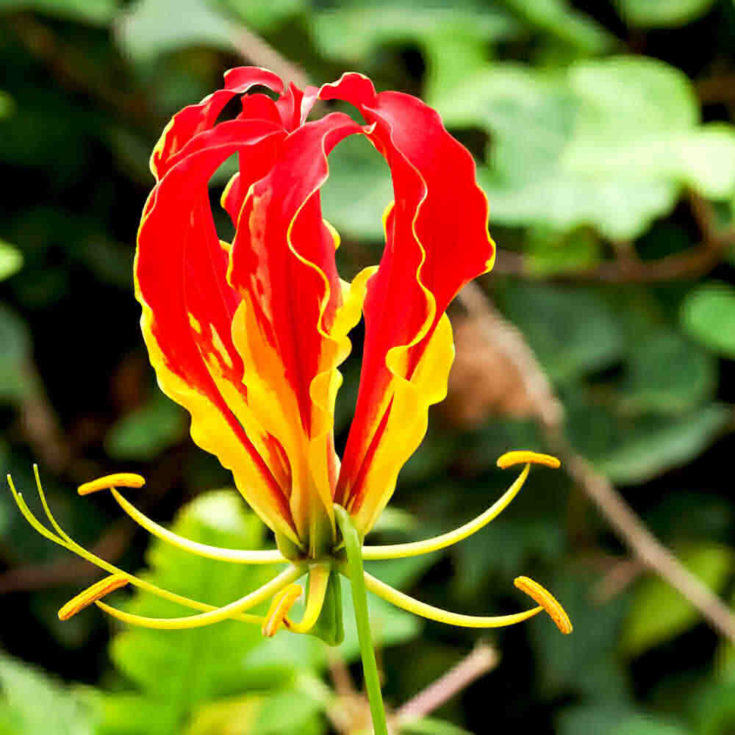
Gloriosa lily is a vining tender perennial with dramatic flame colored flowers. Be sure to give this plant a trellis to climb on.
Materials
- Gloriosa lily tubers
- Compost or other organic matter
- Trellis
- All purpose fertilizer
Tools
- Hose or watering can
Instructions
- Choose a spot that gets 6-8 hours of sun a day.
- Amend the soil with compost or organic matter.
- Add a trellis for the plant to climb on.
- Plant tubers on their side 1 foot apart and cover with soil. Firm well.
- Water often until shoots appear and then glory lily needs 1 inch of water a week.
- Tubers will sprout in 2-3 weeks.
- Fertilize with 1/2 strength formula every two weeks during the growing season.
- Flowers bloom in mid to late summer and into fall.
- Deadheading promotes more blooms.
- Propagate by division once every three years.
- Only hardy in zones 9 and above. In colder areas, lift the tubers in fall and plant again in spring.
Achinta Kumar Halder
Saturday 4th of November 2023
I have seen this flower at Sea sore area wildly grown in West Bengal, Eastern India. It was then blooming in the mid of October. I was so attracted to the color of the flower. Then I searched foe its name and Identification and found it. Now I am interested to grow in my garden. Thanks a lot for providing the information How to grow it in the garden. Thanks you so much.